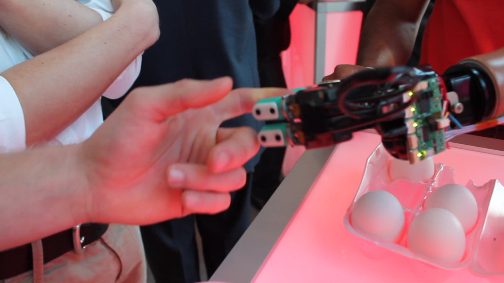A smartphone screen can detect where it’s being touched. But the SynTouch sensor works the other way around: It detects what it is touching.
SynTouch LLC, a Los Angeles-based startup that began in a University of Southern California lab, has developed what it says is the first sensor that enables robots to replicate human touch. The company has been named a 2014 World Economic Forum Technology Pioneer for its main product, the BioTac, a fingertip that can sense force, temperature, and vibration—in some cases more accurately than a human finger.
While many sensors have been developed over the last 30 years, not many products with human-like capabilities have resulted, says Jeremy Fishel, SynTouch’s co-founder. “The approaches people were taking just weren’t similar to how the finger works, and were therefore doomed to fail,” he says.
The BioTac is a robotic finger with sensors in a rigid skeleton, surrounded by a fluid-filled, squishy skin. It has fingerprints, nails, and the shape of a finger, which help the sensor accurately detect vibrations, shapes, and textures.
“Through kind of blindly copying nature we figure out why it’s useful to do that in the first place,” Fishel says. And a soft, moldable, human-finger-like touch sensor has implications across industries, he adds.
The most obvious use for such a fingertip is in prosthetics. The BioTac has already been added to a number of existing prosthetic hands. But Fishel points to other consumer and industrial uses.

The BioTac sensor’s flexibility is what sets it apart from sensors already in industrial robots. Fishel says that previously sensors had to be rigid so they wouldn’t break. Industrial robots compensate for their lack of a sense of touch with heavy, precise machinery, but those features demand rigid sensors and make the equipment expensive. Touch sensing, Fishel says, lets a robot “react to the environment intelligently.”
Technologies like SynTouch could reduce machine costs by half even as they provide better performance. Robots could be “sloppier” and less precise, because they could correct for errors with touch sensors. Lighter robots would also be safer for humans to work with.
This week the SynTouch team received a Popular Mechanics Breakthrough Award, which has previously gone to notable recipients like the NASA Phoenix Mars Mission and Tesla and SpaceX founder Elon Musk. Other winners this year are developing sensors to monitor the pH of oceans and DNA composition, focusing on environmental science and medicine. Popular Mechanics attributed the excitement around sensors to the smartphone revolution, and experts predicted that smarter sensors across industries will change the next generation of technology.
At the awards forum, SynTouch co-founder Gerald Loeb explained that sensors are “a way to get information about states of energy in the world.” Using them makes such information actionable, he said, calling it a Big Data problem.
The data a SynTouch finger collects, for instance, tells the machine how hard or soft to press to achieve a desired result, or what types of fabrics it is touching. In an experiment with 117 fabrics, the finger detected materials with 95 percent accuracy—in many cases more accurately than people can.
The capabilities of this new technology are only beginning to be applied. The extension of such human-like subtlety to machines will likely enable a wide range of previously impossible applications in areas we cannot even imagine.
Sensors Take a Big Step Closer to Human Touch
A smartphone screen can detect where it’s being touched. But the SynTouch sensor works the other way around: It detects what it is touching. SynTouch LLC, a Los Angeles-based startup that began in a University of Southern California lab, has developed what it says is the first sensor that enables robots to replicate human touch. The company has been named a 2014 World Economic Forum Technology Pioneer for its main product, the BioTac, a fingertip that can sense force, temperature, and vibration—in some cases more accurately than a human finger.
















